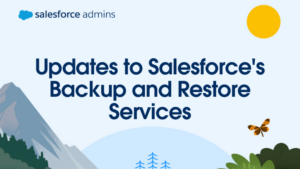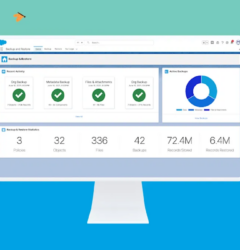In a data age characterized by the exponential growth with the constant threats of cyber incidents, hardware failures, and human errors, the specter of data loss looms ever-present—and for good reason. The ramifications of losing essential data can be catastrophic for businesses, with the average cost of a data breach soaring to $9.44 million in 2022, more than double the previous year’s figure, according to IBM. Cyber Incidents and Salesforce Backup are phrases that go hand in hand.
The data landscape is expanding rapidly; by 2025, the volume of generated and consumed data is expected to surpass 180 zettabytes. When data is lost, organizations face significant downtime in recovery or recreation efforts, resulting in decreased productivity and revenue loss. Gartner estimates that the average cost of IT downtime can be as high as $6,600 per minute or $400,000 per hour.
Data Crisis Example
In this scenario, a customer-controlled data backup and restore plan is as a critical lifeline for businesses. Such a plan allows organizations to spend less time on data recovery and more time on growth opportunities. It becomes especially pivotal in responding swiftly to crises, as demonstrated by the story of Alex, a software developer at a technology company. Despite an unexpected issue during the integration of a new system with the CRM, Alex’s implementation of backup and restore capabilities proved instrumental in quickly recovering deleted data, minimizing the impact on customers and the company’s reputation. This didn’t even involve a cyber incidents and Salesforce Backup still saved the day.
Beyond crisis response, a robust backup and restore solution is essential for avoiding fines resulting from stringent privacy regulations. Non-compliance with data protection laws, such as GDPR, can lead to substantial legal consequences. For instance, GDPR fines alone have surpassed $4.4 billion. By utilizing a backup and restore product, companies like “TechTrends,” an EU-based e-commerce company dealing with sensitive customer data, can protect personal records, ensuring compliance with global data handling requirements and sidestepping penalties.

Cyber Incidents and Salesforce Backup
Investing in data resilience solutions not only shields businesses from financial and reputational consequences but also allows them to concentrate on growth and customer relations. Marla Hay, Vice President of Product for Security and Privacy at Salesforce, emphasizes the importance of a data resiliency strategy in protecting against threats, malicious activities, and human errors. In today’s digitally fraught landscape, a reliable backup and restore product addresses pain points like data loss, downtime, and compliance challenges, empowering organizations to secure critical information and maintain uninterrupted operations.
In an era where data protection and cybersecurity have become top priorities, adopting a dependable backup and restore product emerges as a strategic imperative for building resilience and ensuring sustained growth and success.











